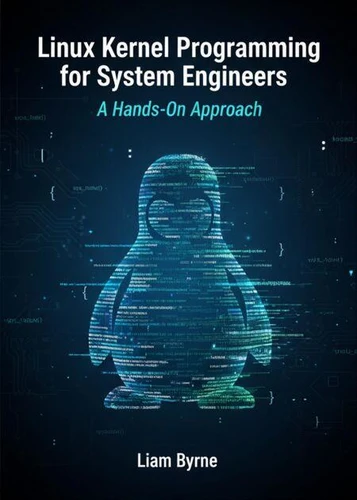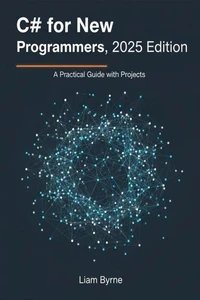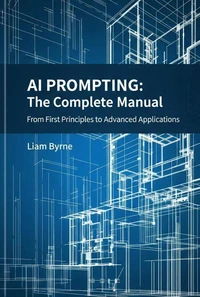Nouveauté
Linux Kernel Programming for System Engineers: A Hands - On Approach
Par :Formats :
Disponible dans votre compte client Decitre ou Furet du Nord dès validation de votre commande. Le format ePub protégé est :
- Compatible avec une lecture sur My Vivlio (smartphone, tablette, ordinateur)
- Compatible avec une lecture sur liseuses Vivlio
- Pour les liseuses autres que Vivlio, vous devez utiliser le logiciel Adobe Digital Edition. Non compatible avec la lecture sur les liseuses Kindle, Remarkable et Sony
- Non compatible avec un achat hors France métropolitaine
 , qui est-ce ?
, qui est-ce ?Notre partenaire de plateforme de lecture numérique où vous retrouverez l'ensemble de vos ebooks gratuitement
Pour en savoir plus sur nos ebooks, consultez notre aide en ligne ici
- FormatePub
- ISBN8232511555
- EAN9798232511555
- Date de parution12/10/2025
- Protection num.Adobe DRM
- Infos supplémentairesepub
- ÉditeurHamza elmir
Résumé
Master the art of Linux kernel programming with this comprehensive, hands-on guide designed for system engineers and developers ready to work at the operating system's core. Linux Kernel Programming for System Engineers takes readers on a practical journey from setting up a secure development environment to contributing code to the Linux kernel community. This book demystifies kernel internals through clear explanations and real-world code examples.
Starting with foundational concepts like kernel architecture and the separation between kernel space and user space, readers progress through essential topics including process management, memory management, device drivers, and system calls. Each chapter builds systematically on the previous one, creating a complete understanding of how Linux operates at its deepest level. What sets this book apart is its emphasis on practical, hands-on learning.
Every concept is reinforced with working code examples that can be compiled, loaded, and tested in a safe virtual machine environment. Readers will write their first kernel module, implement device drivers, work with synchronization primitives, and master debugging techniques using tools like GDB and QEMU. The book covers critical topics often overlooked in other resources, including kernel data structures, interrupt handling, the Virtual File System, and performance optimization.
Designed for system engineers, embedded developers, and programmers with C programming experience who want to advance their careers, this guide provides the knowledge needed to write production-quality kernel code. Whether the goal is to develop custom device drivers, optimize system performance for cloud infrastructure, or contribute to open-source projects, this book delivers the skills and confidence to succeed.
The book follows the modern Linux kernel architecture and includes detailed coverage of loadable kernel modules, memory allocation strategies, concurrency and synchronization, networking internals, and security mechanisms. Extensive appendices provide quick-reference guides to essential kernel APIs and configuration options. Every chapter concludes with practical exercises that reinforce learning and build real-world skills.
By the end of this comprehensive guide, readers will understand the Linux kernel from both theoretical and applied perspectives. They will be equipped to navigate the kernel source tree with confidence, write stable and efficient kernel code, debug complex issues, and participate in one of the most important open-source projects in computing history. This is the definitive resource for anyone serious about Linux kernel development in 2025 and beyond.
Starting with foundational concepts like kernel architecture and the separation between kernel space and user space, readers progress through essential topics including process management, memory management, device drivers, and system calls. Each chapter builds systematically on the previous one, creating a complete understanding of how Linux operates at its deepest level. What sets this book apart is its emphasis on practical, hands-on learning.
Every concept is reinforced with working code examples that can be compiled, loaded, and tested in a safe virtual machine environment. Readers will write their first kernel module, implement device drivers, work with synchronization primitives, and master debugging techniques using tools like GDB and QEMU. The book covers critical topics often overlooked in other resources, including kernel data structures, interrupt handling, the Virtual File System, and performance optimization.
Designed for system engineers, embedded developers, and programmers with C programming experience who want to advance their careers, this guide provides the knowledge needed to write production-quality kernel code. Whether the goal is to develop custom device drivers, optimize system performance for cloud infrastructure, or contribute to open-source projects, this book delivers the skills and confidence to succeed.
The book follows the modern Linux kernel architecture and includes detailed coverage of loadable kernel modules, memory allocation strategies, concurrency and synchronization, networking internals, and security mechanisms. Extensive appendices provide quick-reference guides to essential kernel APIs and configuration options. Every chapter concludes with practical exercises that reinforce learning and build real-world skills.
By the end of this comprehensive guide, readers will understand the Linux kernel from both theoretical and applied perspectives. They will be equipped to navigate the kernel source tree with confidence, write stable and efficient kernel code, debug complex issues, and participate in one of the most important open-source projects in computing history. This is the definitive resource for anyone serious about Linux kernel development in 2025 and beyond.
Master the art of Linux kernel programming with this comprehensive, hands-on guide designed for system engineers and developers ready to work at the operating system's core. Linux Kernel Programming for System Engineers takes readers on a practical journey from setting up a secure development environment to contributing code to the Linux kernel community. This book demystifies kernel internals through clear explanations and real-world code examples.
Starting with foundational concepts like kernel architecture and the separation between kernel space and user space, readers progress through essential topics including process management, memory management, device drivers, and system calls. Each chapter builds systematically on the previous one, creating a complete understanding of how Linux operates at its deepest level. What sets this book apart is its emphasis on practical, hands-on learning.
Every concept is reinforced with working code examples that can be compiled, loaded, and tested in a safe virtual machine environment. Readers will write their first kernel module, implement device drivers, work with synchronization primitives, and master debugging techniques using tools like GDB and QEMU. The book covers critical topics often overlooked in other resources, including kernel data structures, interrupt handling, the Virtual File System, and performance optimization.
Designed for system engineers, embedded developers, and programmers with C programming experience who want to advance their careers, this guide provides the knowledge needed to write production-quality kernel code. Whether the goal is to develop custom device drivers, optimize system performance for cloud infrastructure, or contribute to open-source projects, this book delivers the skills and confidence to succeed.
The book follows the modern Linux kernel architecture and includes detailed coverage of loadable kernel modules, memory allocation strategies, concurrency and synchronization, networking internals, and security mechanisms. Extensive appendices provide quick-reference guides to essential kernel APIs and configuration options. Every chapter concludes with practical exercises that reinforce learning and build real-world skills.
By the end of this comprehensive guide, readers will understand the Linux kernel from both theoretical and applied perspectives. They will be equipped to navigate the kernel source tree with confidence, write stable and efficient kernel code, debug complex issues, and participate in one of the most important open-source projects in computing history. This is the definitive resource for anyone serious about Linux kernel development in 2025 and beyond.
Starting with foundational concepts like kernel architecture and the separation between kernel space and user space, readers progress through essential topics including process management, memory management, device drivers, and system calls. Each chapter builds systematically on the previous one, creating a complete understanding of how Linux operates at its deepest level. What sets this book apart is its emphasis on practical, hands-on learning.
Every concept is reinforced with working code examples that can be compiled, loaded, and tested in a safe virtual machine environment. Readers will write their first kernel module, implement device drivers, work with synchronization primitives, and master debugging techniques using tools like GDB and QEMU. The book covers critical topics often overlooked in other resources, including kernel data structures, interrupt handling, the Virtual File System, and performance optimization.
Designed for system engineers, embedded developers, and programmers with C programming experience who want to advance their careers, this guide provides the knowledge needed to write production-quality kernel code. Whether the goal is to develop custom device drivers, optimize system performance for cloud infrastructure, or contribute to open-source projects, this book delivers the skills and confidence to succeed.
The book follows the modern Linux kernel architecture and includes detailed coverage of loadable kernel modules, memory allocation strategies, concurrency and synchronization, networking internals, and security mechanisms. Extensive appendices provide quick-reference guides to essential kernel APIs and configuration options. Every chapter concludes with practical exercises that reinforce learning and build real-world skills.
By the end of this comprehensive guide, readers will understand the Linux kernel from both theoretical and applied perspectives. They will be equipped to navigate the kernel source tree with confidence, write stable and efficient kernel code, debug complex issues, and participate in one of the most important open-source projects in computing history. This is the definitive resource for anyone serious about Linux kernel development in 2025 and beyond.





